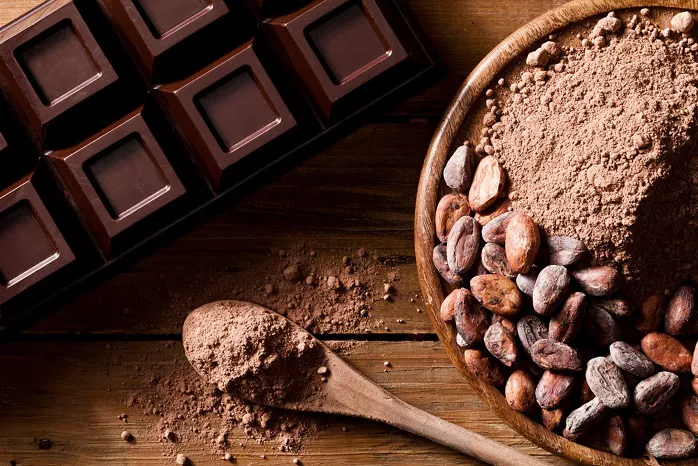When it comes to desserts and beverages, two ingredients often spark confusion among consumers: cocoa and cacao. While they share a similar origin and are both associated with chocolate, there are distinct differences between the two.
In this comprehensive guide, we’ll delve into the nuances of cocoa and cacao, exploring their origins, processing methods, flavor profiles, nutritional benefits, and culinary applications.
Cocoa vs Cacao
Before we delve into the finer details, let’s establish a foundational understanding of cocoa and cacao:
Cacao:
The term “cacao” refers to the purest form of chocolate, derived from the seeds of the Theobroma cacao tree. These seeds, known as cacao beans, are harvested from cacao pods and undergo minimal processing. Cacao is revered for its rich flavor profile and potent nutritional properties.
Cocoa:
Cocoa, on the other hand, is the processed form of cacao. The beans are harvested, fermented, dried, roasted, and ground to produce cocoa powder. Cocoa is a staple ingredient in various confections, including chocolate bars, cakes, cookies, and hot cocoa beverages.
Now that we’ve established the basics, let’s explore the differences between cocoa and cacao in more detail.
Cacao: From Bean to Bliss
Origins and Harvesting: Cacao beans are harvested from the fruit of the cacao tree, which thrives in tropical regions such as South America, Africa, and Southeast Asia. The pods contain the precious cacao beans, which are carefully extracted and left to ferment before being sun-dried.
Minimal Processing:
Unlike cocoa, cacao undergoes minimal processing to preserve its natural flavors and nutrients. Once dried, the beans are roasted at low temperatures to enhance their flavor and aroma. The roasted beans are then cracked and winnowed to remove the outer shell, revealing the prized cacao nibs.
Nutritional Benefits:
Cacao is renowned for its impressive array of health benefits. Rich in antioxidants, minerals, and flavonoids, cacao boasts anti-inflammatory properties and may support heart health, cognitive function, and mood regulation. Additionally, cacao is a good source of magnesium, iron, and fiber, making it a nutritious addition to any diet.
Culinary Applications:
Cacao lends itself to a wide range of culinary applications, from decadent desserts to savory dishes. Cacao nibs can be sprinkled over yogurt, oatmeal, or smoothie bowls for added crunch and flavor. Cacao powder is a versatile ingredient in baking, offering a deep, chocolatey flavor to cakes, brownies, and truffles.
Cocoa: The Refined Delight
Processing Methods:
Cocoa powder is derived from cacao beans that undergo a more extensive processing journey. After harvesting and fermentation, the beans are dried, roasted at higher temperatures, and ground into a fine powder. This process removes much of the natural fats (cocoa butter) from the beans, resulting in cocoa powder.
Flavor Profile:
Cocoa powder tends to have a milder, less bitter flavor compared to cacao. While it retains some of the chocolatey notes, cocoa powder lacks the depth and intensity of cacao. However, it remains a popular choice for its versatility and ease of use in recipes.
Nutritional Profile:
While cocoa powder still contains some antioxidants and minerals, it may have a slightly lower nutritional profile compared to cacao due to the processing methods. However, cocoa powder remains a good source of antioxidants, particularly flavonoids, which may offer various health benefits.
Culinary Applications:
Cocoa powder is a staple ingredient in the world of baking and confectionery. It serves as the base for classic chocolate desserts such as brownies, cakes, and cookies. Additionally, cocoa powder is used to make hot chocolate, chocolate sauces, and chocolate-flavored beverages.
Choosing Between Cocoa and Cacao
When it comes to selecting between cocoa and cacao for your culinary creations, consider the flavor profile, nutritional benefits, and intended application. Here are a few key points to keep in mind:
Flavor Preference:
If you prefer a deep, robust chocolate flavor with a hint of bitterness, opt for cacao. For a milder, more subtle chocolate taste, cocoa powder may be the preferred choice.
Nutritional Content:
While both cocoa and cacao offer health benefits, cacao typically retains more of its natural nutrients due to minimal processing. If you’re seeking maximum nutritional value, consider incorporating cacao into your recipes.
Recipe Adaptability:
Cocoa powder is often the go-to choice for baking and dessert-making due to its convenience and availability. However, don’t hesitate to experiment with cacao in your favorite recipes for a unique twist on traditional treats.
Conclusion
In conclusion, the distinction between cocoa and cacao lies in their processing methods, flavor profiles, and nutritional compositions. While cocoa undergoes extensive processing to yield a milder powder, cacao remains closer to its raw form, boasting a rich, intense flavor and potent health benefits.
Whether you’re whipping up a batch of brownies or indulging in a decadent chocolate treat, understanding the differences between cocoa and cacao allows you to make informed choices and elevate your culinary creations.
So go ahead, embrace the cocoa-cacao conundrum, and savor the rich flavors of chocolate in all its delightful forms.























